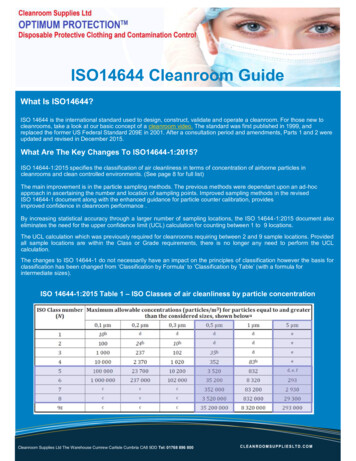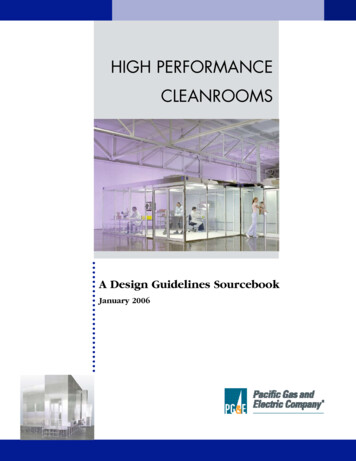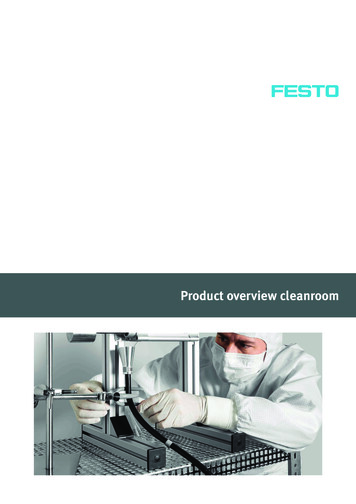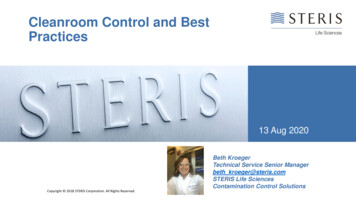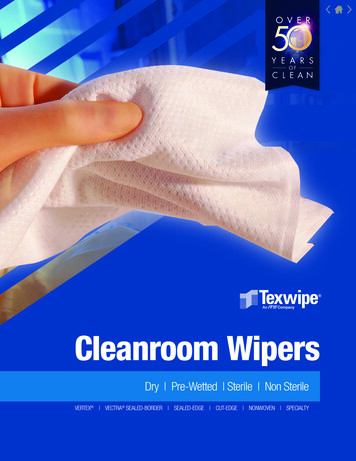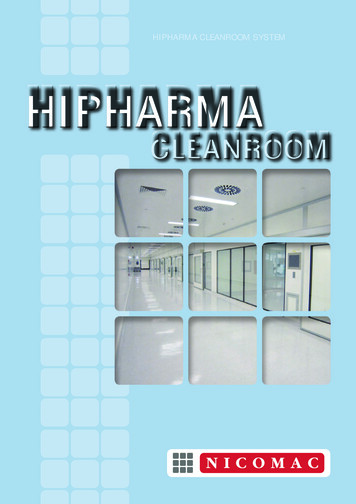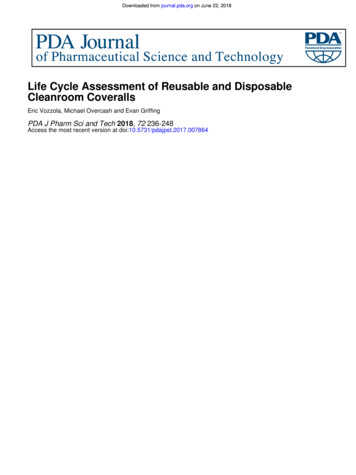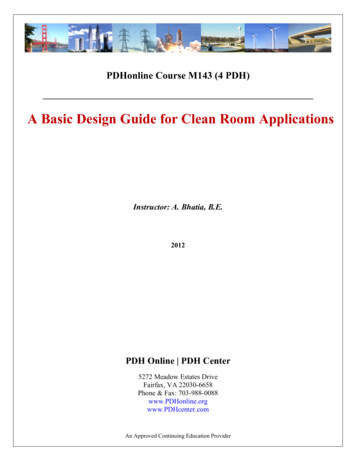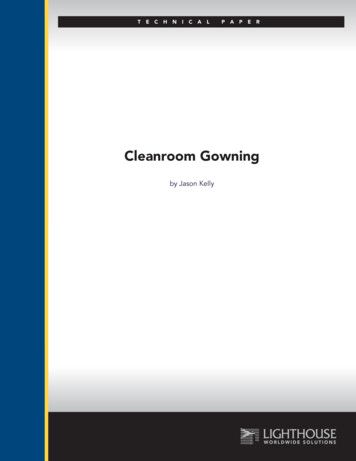
Transcription
TECHNICALPAPERCleanroom Gowningby Jason Kelly
Technical PaperCleanroom GowningAuthor: Jason Kelly Vice President of Services Lighthouse Worldwide SolutionsWhat are the regulatory requirements?Although there are no federal regulations for sterile cleanroom garments used in thepharmaceutical industry, guidance for the industry is available from The Institute ofEnvironmental Sciences and Technology (IEST), which publishes a recommended practice IESTRP-CC003.3, “Garment Considerations for Cleanrooms and Other Controlled Environments.”Regulatory guidelines advising on the suitability of garments for the various cleanroomclassifications include: EudraLex, Volume 43International Standard ISO 14644-4:2001(E) Annex A4Rules and Guidance for Pharmaceutical Manufacturers and Distributors, Annex 1521 CFR 211 (b)6Biggest source of contamination is YOU!Copyright Lighthouse Worldwide Solutions Inc., c 2019
Technical PaperThe biggest source of contaminants, by far, is human personnel. Unlike inanimate objects,human beings cannot be sterilised. Even when sitting perfectly still, they continuously spreadaround dead skin, hairs, microbes, and other pollutants.Therefore, it is necessary for cleanroom personnel to wear specially designed clothing that canserve two functions:1. preventing natural human contaminants from infecting the environment2. protecting the wearer from hazards in the immediate areaGowning ConsiderationsLike so many beneficial accessories, cleanroom apparel must be used correctly to obtainits full range of benefits. It requires a precise sequence of actions to ensure that theclothes do not become contaminated. Exactly how this sequence goes depends on theneeds of the particular facility, including its ISO cleanroom classification. There is nostandardized gowning procedure that applies to every environment.In general, though, the gowning procedure involves thoroughly cleaning exposedskin (including the removal of cosmetics) and any clothing that will be wornunderneath the cleanroom apparel. Jewelry must be removed or at least completelycovered. Personnel must be able to don their clothing while preventing it from touchingthe ground, where it can pick up contaminants, at any time during the process. Manycleanrooms place a sticky mat before the entrance to remove dirt and othercontaminants from the shoes of personnel.While cleanroom garments can either be disposable or reusable, according to industryanalysts, most sterile facilities will opt for disposable garments due to contaminationconcerns relating to reusable garments returned from laundering facilities. In somecompanies, disposables may be used at some locations and reusables at others. This can depend on theclasses of the various cleanrooms at different locations.Most operators in a sterile cleanroom environment in the pharmaceutical industry will wear three tofour disposable suits in a day, each suit being worn for two to three hours at a time. Often, cleanroomprotocol dictates that garment changes must be made each time the cleanroom is re-entered. Oncediscarded, these suits can be incinerated, or they can be re-purposed through a garment recoveryservice that will take the used garments and sell them back into non-sterile applications.When a cleanroom operator is due to start any aseptic gowning process, it is paramount that the correctsize garment (coverall, hood and overboot) is available on each occasion. This removes any potential forthe user to take a poorly fitting garment that could increase the risk of contaminating the cleanenvironment. The management and control of all aseptic gowning inventories, therefore, mustcommence well before the operator dons a cleanroom garment. Among the aspects to be consideredand managed are:Copyright Lighthouse Worldwide Solutions Inc., c 2019
Technical Paper The supply, storage and rotation of stockThe availability of the correct size and type of gowns at all times, at all storage locationsEffective and ‘in date’ operator training, i.e. operatives must be assessed regularlyA defined process of how to handle damaged garments and a documented maximum number ofwashing cycles and repairs.Gowning TrainingTraining should be provided using visual means, i.e. viavideo technology, as this not only demonstrates andstandardises the correct aseptic gowning technique,but a recording of the operator’s gowning technique(particularly for higher classification areas) can also beused to offer particular feedback. Beer6 states that theuse of video replay enables operators and the trainer toidentify improper or subtle flaws in technique. This canhave particular impact when used in conjunction withmicrobial monitoring – for example, when a trainee hastheir aseptic gowning technique assessed using contactplates. If a count on these plates comes back high it isuseful to review this data in conjunction with thevideotape to see if it corresponds to poor gowningtechnique, enabling the trainee to see exactly whataspects of the technique they need to work on.Cleanroom Gowning Best PracticesCleanroom gowning protocols differs depending on cleanroom class and application. In ISO Class 7 orISO Class 8 cleanrooms, frocks are often acceptable. A cleanroom classified as ISO Class 5 or ISO Class 6(or cleaner) requires cleanroom coveralls, along with hoods, gloves, and booties (shoe covers). Forsterile processing, additional precaution is needed to assure that no sterile surfaces contact non-sterilesurfaces during gowning, processing, or cleaning.Copyright Lighthouse Worldwide Solutions Inc., c 2019
Technical PaperCleanroom Gowning Procedure Checklist1. Before entering gowning room taking at least three small steps with each foot; remove dirtysticky mat layer if needed.2. Use a shoe brush cleaner3. Don shoe cover booties4. Don cleanroom bouffant5. Wash hands thoroughly (use waterless alcohol solution for USP 797)6. Put on cleanroom glove liners7. Apply alcohol solution to outside of liners8. Put on cleanroom gloves9. Wash or apply alcohol solution to cleanroom gloves10. Apply cleanroom bouffant (beard covers for those with facial hair)11. Apply a freshly laundered cleanroom hood12. Attach facemask13. Apply coveralls, only touch the floor on the clean side of a gowning bench14. Hoods are tucked inside of coveralls15. Put on cleanroom booties16. Put on cleanroom gloves17. Ensure that booties and gloves overlap the coveralls18. Wipedown the gowning bench with a clean, sterile wiper19. Use cleanroom mirror for self-checkCopyright Lighthouse Worldwide Solutions Inc., c 2019
9. Wash or apply alcohol solution to cleanroom gloves 10. Apply cleanroom bouffant (beard covers for those with facial hair) 11. Apply a freshly laundered cleanroom hood 12. Attach facemask 13. Apply coveralls, only touch the floor on the clean side of a gowning bench 14. Hoods are tucked inside of coveralls 15. Put on cleanroom booties 16.
